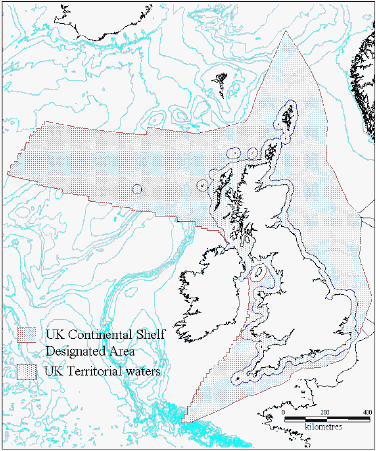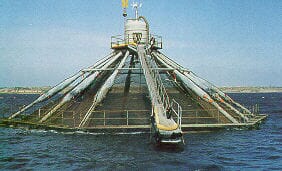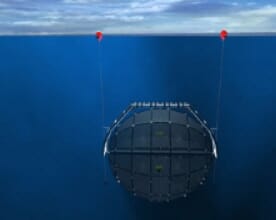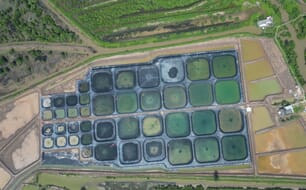For many years, there has been a growing tide of interest in taking aquaculture “offshore”, but despite regular surges of research and some commercial activity, there has been relatively little progress towards realising the anticipated potential of this “unexploited” environment (Figure 1). In a recent Defra and Seafish sponsored study¹, we were charged with providing a critical assessment of the potential for open ocean offshore aquaculture in UK waters using candidate species which would have similar growth and performance characteristics to Atlantic salmon (Salmo salar – Species A) and Atlantic cod (Gadus morhua – Species B) and with due reference to other potential species candidates. This appraisal addresses economic, financial and marketing issues, with specific reference to modelled scenarios of a conceptual large-scale open ocean mariculture system. The environmental, legal and technical implications for offshore aquaculture development are examined in a general context and this article summarises some of the report’s conclusions.
 |
|
Figure 1. Likely maximum extent of UK offshore area. Based on UK Continental Shelf designations, and including UK limit of territorial waters (12nm). (Note that the area is not coincident with the 200nm fisheries limit.) (After - www.jncc.gov.uk/page-1478 - March 2006). World Vector Shoreline copyright US Defense Mapping Agency, Bathymetry copyright GEBCO Digital Atlas, British Oceanographic Data Centre on behalf of IOC and IHO 1994 & 1997. UK Continental Shelf designations courtesy Department of Trade and Industry via DEAL website www.ukdeal.co.uk
|
Financial and Economic Perspective
The study presents a wide range of information about economic modelling, including ‘Core’ models for the two species options, based upon a suit of realistic assumptions, together with sensitivity analyses, varying a range of assumption categories. The key point for offshore aquaculture is that it must make good returns on capital right from the start. A fastergrowing species is more likely to achieve the necessary returns.
The outcome of the modelling exercise does not suggest any particular ‘economy of scale’ advantage for large installations. Even modelling across a range of unit pen costs from £5.00 to £1.00 per m³ only improves the core Species A IRR (internal rate of return) from 14% to 17%. It would appear that there is no overwhelming economic advantage or disadvantage of the offshore system concept in terms of replacing existing inshore pen aquaculture, unless such inshore systems became more expensive due to as-yet unforeseen additional regulatory or other costs.
The sales price of the fish being grown is the most important variable and would-be investors in offshore aquaculture must have a very clear market-led vision, and a robust marketing plan. There are several species of marine finfish being farmed around the world with market values in excess of £3.00 per kg, which would appear to be a viable price level for offshore aquaculture.
This initial overview seems to indicate that for any future high-volume offshore aquaculture in UK waters, and with UK markets in mind, species with a market proposition that can deliver fillets to consumers at around £7 to £8 per kg will need to be considered.
The economic modelling in the study has followed the same presumption as that made by Ryan², i.e. that a production scale in the region of 10,000 tonnes per annum (tpa) would be required. One of the key factors to consider is the nature of the staffing for offshore aquaculture. The model has been predicated on 5,000 tpa ‘farming units’ with just 8 staff assigned to each. It is difficult to contemplate much smaller units, since there would need to be a pro-rata reduction in staff numbers.
Offshore aquaculture would appear to be a potentially viable way of farming fish, but the scale of operation would need to be significant in order to achieve proper economy of scale. Investment packages in excess of £20 million are indicated for a 10,000 tpa operation. Industrial investors, i.e. existing major aquaculture companies, are unlikely to be persuaded that there is any compelling advantage to moving offshore at this time. Pure financial investors would probably be very cautious.
The study indicates that there may be interesting prospects for offshore finfish cultivation (and in relation to market expectations) if considered in a global (rather than UK) context.
Ecological Considerations
Whilst it is likely that offshore aquaculture production will have less direct environmental impact than is typically attributed to inshore sites³, there is little scientific evidence to support some of the acclaimed benefits. The total volume of water exchange may be greater and therefore the dilution factor may be higher for any given pollutant, but this may need to be assessed on a site-by-site, system-by-system basis.
If the biological limitations of the stock dictate that cultivation takes place in conditions which are the same as those that apply inshore, the impacts may indeed be similar. Take for example a situation where, despite a water depth of 80m, the prevailing wave climate and current regime suggests that optimal cultivation would need to take place at a depth of 20 – 30m.
In reality, this situation is perhaps not very different from some deeper inshore sites. If one also assumes that farms may need to be of significantly greater scale to offset the additional cost of offshore operations, the notion of less environmental impact may be challenged – particularly, if at such depths the processes of degradation of solid waste material are much slower due to lower temperature and a generally more impoverished benthic community.
Given the proposed scale of some offshore aquaculture ventures, the issue of stock containment and stock security is an important consideration. The escape or release of large numbers of hatchery reared stock would be considered unacceptable and could have a disproportionate impact on some wild stocks where the relative number of wild fish is low – as a result of over fishing for example!
There is anecdotal evidence suggesting that disease incidence is lower in fish farms in exposed conditions and the assumption is that there will be less disease in fish cultivated offshore. However, there is little scientific evidence or practical commercial scale experience in offshore sites to support this assumption. Physical separation from disease agents, particularly parasites which may require intermediate hosts located inshore would be advantageous. But wild stocks of fish could provide a reservoir for disease transfer which may be capable of infecting offshore sites. If the offshore site or resident fish population is “disease” free, it is also possible that farm stock could be a disease vector.
The proposed siting of offshore aquaculture farms in close proximity to offshore oil and gas platforms, with a view to re-use or couse of facilities and logistics is, in theory, an attractive proposition. But, the potential impact of produced water discharges, drill cuttings and other spillage for example, will need to be considered.
Legal Implications
Beyond the 3nm limit there are some serious legal and regulatory anomalies that would need to be addressed before aquaculture could take place and for the UK to remain compliant with its obligations under international and EU legislation. It is possible that the landmark judgement which now requires the UK to observe the Birds and the Habitats Directives out to 200nm could apply to other EU Directives pertinent to aquaculture.
In Scotland, planning authorities have the capacity to grant permission for a fish farm site out to the 12nm limit, whereas the principal regulator of fish farm discharges (SEPA), has a remit to 3nm only. Beyond the 12nm territorial limit, the legal and regulatory picture becomes even more confused in that the UK has not formally declared an EEZ, but through UNCLOS relies upon the designation of zones to cover specified activities regulated by a competent authority, none of which currently refer to aquaculture per se. Whilst some of the established zonal regulations would have some relevance to aquaculture activities, it would seem likely that additional regulation would be required to properly consent and regulate the activities of this industry out to 200nm.
Technical, Biological and Logistical Considerations
Typically, marine cage farming sites in Scotland are in sea lochs in relatively unexposed (Class 1 and 2) locations. The technology and expertise to conduct cage culture aquaculture in an economically viable context already exists in relatively near shore environments with significant wave heights of up to 1.0 – 2.0 meters (Norwegian site Class 3). The biologically limiting factor in such cases is normally the effect of current speed on the stock. At present, there is no aquaculture production occurring in UK waters in high or extreme exposure environments (Class 4 or 5). Elsewhere, offshore cage culture is of relatively limited scale and largely experimental.
| Table 1: Norwegian aquaculture site classification scheme (after ²). The average height of the highest one third of waves recorded in a given monitoring period. Also referred to as H1/3 or Hs | ||
| Site Class | Significant Wave Height (Hs)(Meters) |
Degree of Exposure |
|---|---|---|
| 1 | <0.5 | Small |
| 2 | 0.5-1.0 | Moderate |
| 3 | 1.0-2.0 | Medium |
| 4 | 2.0-3.0 | High |
| 5 | >3.0 | Extreme |
Such exposed environments remain challenging and are unexploited in the UK because economically more favourable sites in sheltered near shore situations have been sufficient, particularly in Scotland. The wave climate that exists in the UK offshore environment, coupled to prevailing weather conditions strongly suggests that finfish aquaculture will need to be conducted in cages or enclosures capable of being submerged for up to several tens of metres for periods of several days and possibly for prolonged periods at lesser depths.
Whilst there is some potential to further adapt existing cage systems it is widely accepted that novel technologies are required to successfully prosecute aquaculture in most open ocean situations. Many of the cage structures tested over the last 20 years have failed to progress beyond the pilot stage as a result of high cost, structural failure and simply being unfit for the purpose of on-growing fish.
There is a need to focus effort on the development of remote systems for monitoring every aspect of production at sea. Much of this technology and expertise could be developed in existing fish farms situations.
There is a need to focus effort on the development of remote systems for monitoring every aspect of production at sea. Much of this technology and expertise could be developed in existing fish farms situations.
 |
| Figure 2 Farmocean cage deployed (http://www.farmocean.se). |
At present, there do not appear to be any “offshore” cages in use in the UK. Of the designs that are either available or in pilot scale trials, the Farmocean (4, Figure 2) and OceanGlobe (5, Figures 3 & 4) cage systems would seem to be the most practical for offshore conditions. The OceanGlobe, if successful in trials and of reasonable capital cost, appears to be the most “holistic” design produced thus far. Neither of these systems is designed to function in the offshore conditions which characterise the vast majority of UK waters beyond territorial limits. Some of the more extensive enclosures which rely upon tension to maintain net volume are appealing in concept, but present significant practical challenges in terms of husbandry and maintenance.
 |
|
Figure 3 Diagram of OceanGlobe in service position at the surface (http://www.byks.no) |
 |
| Figure 4 Submerged to avoid bad weather, algal blooms, jellyfish or comply with optimal growing conditions for cultivated species. |
The biological scope of the fish may prove to be a significant limitation on offshore cultivation. The conditions within the cage must be conducive to optimise the growth performance of the fish and there appears to be little information on the optimal depth, current speed, light regime etc., applicable to cultivating fish in offshore conditions. Current speeds outside the cage which exceed 1 m/s are, for example, not generally recommended. Photoperiod control may be required to minimise maturation, whilst maintaining optimal growth and feeding opportunities. Anadromous fish requiring to take-in air to equalise their swim bladders will need special provision if they are to be cultivated in submerged cages. The speed with which cages can be raised and lowered will need to be dictated by the fish’s ability to physiologically accommodate the change in pressure.
Options
The notion of developing large scale fish cultivation in the offshore (open ocean) is clearly appealing if framed in the context of virtually unlimited space, less rigorous regulation, significant economies of scale (if achievable), reduced environmental impact and reduced reliance on wild caught fish stocks etc. From a strategic perspective, greater control over the supply and quality of fish available within the UK and for export may also be a valid consideration. However, thus far, commercial interest in offshore cultivation has been confined to countries where conditions dictate that aquaculture can only develop in more exposed locations – most of which are, in reality, Class 3 sites rather than open ocean.
Worldwide, interest in offshore aquaculture is showing resurgence, fuelled for example, by fears over the predicted FAO fish gap and in the US by recent legislative changes which now permit offshore aquaculture development.
If the UK aquaculture industry is to expand significantly both in terms of production and geography, there will be a requirement to consider more exposed farm sites (Class 3) in the first instance and, if necessary, offshore sites. Logically, this progression would probably involve adapting and exploiting established technology and expertise, rather than the more costly and much higher risk scenario of developing systems capable of truly offshore operation.
Co-use or possible re-use of the UK’s considerable inventory of fixed offshore oil, gas and now renewables structures could, in principle, offer a shortcut to offshore aquaculture becoming established. But, economic and practical aspects of combining aquaculture production with operational oil and gas platforms would seem to preclude this as a viable option. The growth in offshore renewable energy may provide a genuine opportunity for certain types of aquaculture and the sector should seek to align itself with offshore renewables development with a view to capitalising on potential synergies.
If offshore aquaculture is to be considered as a strategically desirable way forward, the UK (both government and industry) would need to allocate additional resources for R&D or refocus current budget priorities. To spread both cost and risk the UK should actively seek to engage with international efforts to develop offshore technology. Specific, well planned and rigorously co-ordinated pilot scale initiatives could also be considered.
If pilot scale projects are to be taken forward, it would seem logical for these to be conducted within the 3nm limit in the first instance because, at present, this is the only area where a proper consenting and regulatory framework exists for aquaculture in UK waters. Many of the biological and technical precursors highlighted in the report, which would be required to underpin the viability of offshore aquaculture, could potentially be tested with existing cage systems in appropriate exposed sites.
The report advocates careful consideration of properly justified calls for R&D in support of aquaculture development in more exposed locations with a view to better defining the prospects for full offshore operations in the future.
References
The full report is available at http://www.defra.gov.uk/science/Project_Data/DocumentLibrary/FC0934/FC0934_3856_FRP.pdf1 James, M.A. and Slaski, R. (2006) Appraisal of the opportunity for offshore aquaculture in UK waters. Report of Project FC0934, commissioned by Defra and Seafish from FRM Ltd., 119 pp.
2 Ryan, J. (2004) Farming the Deep Blue. Publ. BIM (Irish Sea Fisheries Board) and Marine Institute.
3 Benetti, D., Brand, L., Collins, C., Orhun, R., Benetti, A., O’hanlon, B., Danylchuck, A., Alston, D., Rivera, J., & Cabarcas, A. (2006) Can offshore aquaculture of carnivorous fish be sustainable. Case studies from the Caribbean. World Aquaculture 37 (1) 44-47.
4 http://www.farmocean.se
5 http://www.byks.no
July 2007

